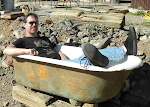Oh No! My Oil Tank Leaked! by Bob Iles
in Home (submitted 2011-07-25)
Part I of Series on Residential Tank Removal Procedures in New Jersey
Every day in New Jersey, underground storage tanks, or USTs, are being removed. And every day, a leaking tank is discovered. Today you had your UST removed and you learned that it leaked. Now what do you do? This series of articles will explain the process.
The first thing to remember is not to panic. Leaking tanks are a common occurrence. Yours is not the first to leak, nor will it be the last. Fortunately, there is a process in place to deal with the issue.
According to the regulations put forth by the New Jersey Department of Environmental Protection (NJDEP), a leaking oil tank must be immediately reported. The notification results in the issuance of a case number for your property. Eventually, you will receive standard correspondence from the NJDEP. Do not lose or throw away this correspondence. It will be important at a later time.
Upon notification of the NJDEP, it is advisable to contact your homeowner's insurance carrier about the release. If contamination above the State's clean up standards has impacted the local ground water, or has migrated beyond your property line, you may have a third party liability claim. Most homeowner's insurance policies provide coverage for a claim of this type. It is important to start the claim process as soon as possible, and to keep the insurance carrier in the loop from the moment the leak is discovered.
After you notify your homeowner's insurance carrier, it is very likely that they will request a Third Party Coverage Investigation at your property. This should be done at no cost to you, and will most likely be conducted by the carrier's own environmental consultant. The insurance carriers consultant will generally contact you by phone within 24 to 72 hours after your initial notification. The consultant will likely ask you for some background information and will schedule a date with you to perform the required investigation.
Once the field investigation is completed, it may take up to three weeks for your homeowner's insurance carrier to make a coverage determination. Be sure to ask your carrier for a copy of the report of findings that was submitted to them by their consultant. It can be valuable to have your contractor or consultant review the report to determine whether the investigation was completed in compliance with the applicable regulations.
Be patient. This is a lengthy process that can sometimes take years to complete. It is important that you have a contractor or consultant working for you that is licensed to complete New Jersey oil tank removals so that you can be assured that the necessary work will be completed in accordance with the regulations.
In the next article, we will discuss the process as it evolves from the initial Third Party Coverage Investigation. For more information on New Jersey tank removal visit Active Environmental's Residential Oil Tank Services site on the web.
About the Author
The author formerly worked for 13 years as an environmental consultant and project manager. He now works as the Corporate Communications & Marketing Director for Active Environmental Technologies (AET) in Mount Holly, New Jersey.
Monday, July 25, 2011
Subscribe to:
Post Comments (Atom)



No comments:
Post a Comment